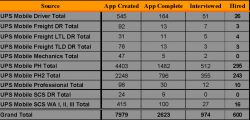 When we last left off, UPS said that the candidates who were coming its way via Facebook and Twitter were more likely to convert to actual hires than were any old candidates. But the sample was small: in other words, social media recruiting seemed to pay off in terms of ROI, but not in any large volume.
When we last left off, UPS said that the candidates who were coming its way via Facebook and Twitter were more likely to convert to actual hires than were any old candidates. But the sample was small: in other words, social media recruiting seemed to pay off in terms of ROI, but not in any large volume.
Things are different now.
As 2010 progressed, TMP’s Mike Vangel says that UPS wanted to know: “What was the ability to scale? Would we be able to continue at the same rate of growth? Would it plateau, or would it accelerate?”
So far: no plateau. UPS attributes 955 hires in 2010 to the social media efforts, breaking down like this: 45 from Twitter (out of 681 people who arrived via Twitter and created applications); 226 from Facebook (out of 3,926 people who created applications); 84 from text-messaging (out of 1,004 who created applications); and 600 from people (out of 7,919 creating applications) going to UPS’s mobile-friendly careers page from a mobile device. That mobile-friendly site had about 510,000 page views in the last 4-5 months of 2010, with people averaging about a minute and a half each on the site.

Matt Lavery, UPS’s Atlanta-based corporate workforce planning manager, says that all these numbers are based on tracking, not from the proverbial drop-down menu asking people, “where’d you hear about us?”
The 955 may even be understated, he says. “There may be more out there. We really believe there are.”
UPS launched its Twitter page in April 2009, and Facebook that October. In 2009, it hired seven people through Twitter, 12 through Facebook, and 10 through text-messaging. Back then, with few social-media hires, its cost per hire was in the $1,000 ballpark. Now, it’s more like $60-70.
What UPS is tracking is the last media used. In other words, the stimulus. Let’s say I’ve been a fan of UPS on Facebook for a year. But I finally decide to apply for a job after seeing a Tweet asking me to send a text message. In that scenario, I’m part of the 84 text-message people mentioned above, not the 226 Facebook people, not the 45 Twitter people.
Speaking of all that: I asked Mike Vangel how these 7,919 people (and 600 hires) were driven to UPS’s mobile site. For example, did UPS put an ad on ESPN.com, telling people there were jobs open at UPS, and that people should check out the careers site or send a text? In short, the answer’s no. UPS didn’t use much paid media; it used social media to spread the word and lure people to visit its jobs pages, or to send a text.
Two-way Street
The UPS Twitter feed now has about 4,663 followers, created without reciprocating; UPS doesn’t follow many others, making it a little harder to attract followers. On Facebook it has about 14,365 fans, about 95% U.S.-based.
Like others — Intel, for example — UPS is spending 2011 improving this work in progress. Lavery says that the company doesn’t want to just broadcast jobs through already-created channels. It’s going to have more people work on social media recruiting, making it more interactive, more of a conversation, less one-way. It’ll make more videos, and have more ways for candidates to interact with current employees.
It’s going to redo its careers website. Right now, it’s not so easy to search by a very specific location. People are often sent to the general search page, because that’s how the site’s currently structured, but UPS, as an example, may want to send people from an advertisement to the search results for only some parts of Chicago.
UPS has come far. About five years ago, ad budgets were decentralized, and almost all dollars were spent on things like print, TV, and mailers. About 3-4 years ago, it started centralizing, and now less than 1% is spent on that sort of media. Money and time are now spent on job boards, social media, and search engine optimization.